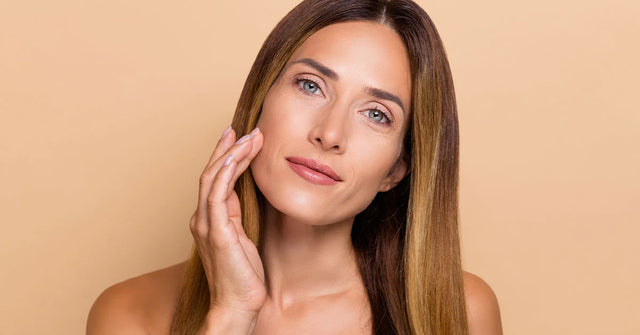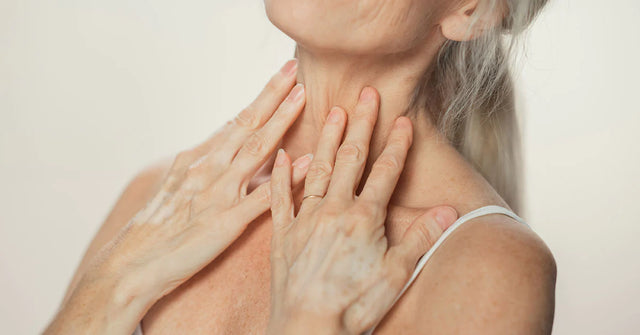Pores can vary in appearance, but did you know that we have oil glands called sebaceous filaments that are responsible for their size? If you’ve been wondering how to decrease the size of your pores, you have to begin by learning how to shrink oil glands.
Those pesky blackheads on your nose? They’re actually sebaceous filaments! When excess sebum clogs the oil glands, it can lead to breakouts on your complexion. In this article, we’ll tell you everything you need to know about oil glands and how to effectively shrink their appearance with both easy home remedies and medical treatments.
Types of Pores Above Your Oil Glands
The two different types of pores are sebaceous filaments (or sebaceous pores) and sweat pores. Distinguishing between the two can help determine which one may be causing your skincare issues. Here’s how they differ.
Sebaceous Pores
Sebaceous pores are thin, tube-like structures that surround the hair follicles. Although they’re not the same as blackheads, they can resemble one another closely, and their role is to help direct the flow of oil within the pore lining. If you’re wondering how to shrink sebaceous glands, begin by using clarifying products and boosting hydration.
Although there are other causes of oily skin, dehydration can lead to overactive pores, which produce an excess amount of sebum, to make up for the lack of moisture. To prevent or combat this problem, hydrate your skin with a hyaluronic acid serum and a lightweight moisturizer to ensure optimum hydration levels.
Sweat Pores
Sweat pores are small tubular glands that produce water, electrolytes, and urea, and they secrete the liquid which we know as sweat. Most commonly found in the armpits, the palms of the hands, and the soles of the feet, it’s important to regularly cleanse these areas to limit breakouts, body odor, and the possible growth of fungus or bacteria.
While you can’t shrink the sweat pores, improving personal hygiene and using the right products can minimize the amount of sweat they produce. This will reduce the risk of them becoming inflamed and causing breakouts.
How to Shrink Oil Glands
If you want to learn how to get rid of oil glands on your face, this section will outline 9 home, lifestyle, and medical methods which target the root causes of oily skin, helping to slow sebum production and shrink the glands and pores.
Home Remedies
Witch hazel contains natural astringent properties that are great for managing sebaceous filaments and sweat glands. In fact, witch hazel may both clear breakouts and act as an antiperspirant! It helps zap away excess oil, clarify, and shrink the pores.
Baking soda is another popular home remedy for shrinking both sweat glands and sebaceous filaments. Since baking soda is extremely alkaline, it has the natural ability to repel sweat. It could also help to unclog sebaceous filaments when applied to the skin. Mix a little into your cleanser and use it as a mask for best results.
Manage Your Stress
Stress can have a negative impact on your skin, as the added anxiety can lead to a boost in the synthesis of the stress hormone cortisol, which triggers the glands to release more sebum or sweat.
Stress can also impact your health negatively in other ways, including weight gain or loss, irritability, anxiety, racing thoughts, and depression. Untreated stress can have serious mental, emotional, and physical complications. Consult your doctor if the symptoms are severe.
Use Retinol
Retinol, or Vitamin A, has numerous benefits for the skin, including shrinking sebaceous filaments and decreasing sweat production. It’s one of the most effective ingredients for oily skin since it naturally tightens the pores and inhibits oil production.
Incorporate products with retinol into your facial skincare regimen to regulate sebum activity. Additionally, opt for a deodorant or antiperspirant with a little bit of retinol to help speed up cell turnover and boost skin health.
Moisturize Regularly
Regular skin hydration is key to preventing excess oil production. When the skin is dehydrated, it produces more oil in an attempt to lubricate. While it’s best to use antiperspirant in areas where you sweat, you should use a rich moisturizer on regions with oil glands.
Infusoderm Daily Moisturizer provides deep hydration using climate-resistant snow algae and antioxidant-rich ingredients like caffeine and cloudberry to boost the skin’s natural moisturizing factor. In fact, a clinical study showed that 89 percent of users saw a significant reduction in skin dryness within four weeks!
Follow a Proper Skincare Routine
A strong skincare routine can help regulate oil production and shrink the glands on both your face and body. Practice good body hygiene by showering daily using a natural, high quality soap, and apply deodorant to help regulate your sweat glands.
In addition, it’s important to follow a regular skincare routine on your face and neck both morning and evening. Begin with a rich cleanser and follow up with a toner to remove excess oils and dirt from the complexion. Use clarifying products that prioritize exfoliation and astringents to reduce blackheads and enlarged pores. Finish your routine with a hydrating moisturizer with SPF and sunscreen for protection from UV rays during the day.
Since sebaceous filaments require the same treatment as blackheads, try our Blackheads + Enlarged Pores Set to cleanse the skin, even out tone, shrink your oil glands, and decrease breakouts. With ingredients like seaweed, witch hazel, and lavender extract, this set clarifies and soothes to restore balance to the skin.
Use Sunscreen
It’s important to wear sunscreen every day when you are outside, 365 days a year, to protect your skin. Investing in a quality sunscreen can help prevent dehydration and photo-aging damage, and not wearing it may exacerbate oil gland activity by rupturing the skin barrier.
In the morning, prioritize sunscreen daily as the last step in your routine. It both protects and helps to hydrate the skin, so it doesn’t overproduce oil. As a result, this may minimize pore size and prevent further damage.
Make Use of Salicylic Acid
Struggling with how to reduce oil production on the face? It might be time to include salicylic acid in your skin exfoliation routine. The beta hydroxy acid (BHA), salicylic acid, works by exfoliating the pores to remove excess oil, dirt, and bacteria. It deeply clarifies and dissolves buildup.
Using a salicylic acid facial or body wash can help regulate overactive oil or sweat glands, as it has mattifying properties. Depending on how sensitive your skin is, you should use it 3-5 times a week for best results. In fact, salicylic acid is one of the best over-the-counter ingredients for shrinking oil glands!
Medical Treatments
As an alternative or complement to home remedies, you may also want to consult with your doctor or dermatologist about medical options for shrinking your oil glands. The physician may recommend some of the following procedures.
Laser Therapies
Laser therapy involves the use of red and primarily blue light to reduce inflammation in the glands and kill the bacteria responsible for the excess oil production. If you’ve tried other options and haven’t been successful, then laser therapy might be a good choice.
Chemical Peels
Chemical peels involve the use of a solution to remove the outer layer of your skin, and they’re
Incredibly effective when it comes to shrinking oil glands, regulating sebum production, and sloughing off dead skin cells.
Microneedling
Microneedling is a procedure that has skyrocketed in popularity over the last few years. Beloved by a number of Hollywood celebrities, the process involves pricking the skin with microscopic needles to stimulate collagen synthesis and speed up the skin’s natural healing process.
FAQs
Question #1 – What causes overactive oil glands?
Overactive oil glands are caused by factors like diet, hormones, medication, genetics, and the environment. If you’re unsure why you have this issue, contact your doctor or dermatologist to check whether it’s related to a medical condition.
Question #2 – How to shrink oil glands on the nose?
In order to shrink sebaceous filaments on the nose, cleanse and use toner in the evening and apply a salicylic acid-based exfoliant 3-4 times a week to keep the glands free and clear of pore-clogging debris. Shrinking the oil glands on the nose requires the right products, time, and patience.
Question #3 – How to get rid of clogged oil glands on the face?
Chemical exfoliation with alpha hydroxy acids like glycolic or lactic acid and beta hydroxy acids like salicylic acid can help cleanse the oil glands and pores. Retinoids speed up cell turnover to decongest pores and clogged oil glands.
Question #4 – How to get rid of visible oil glands?
A regimented skincare routine is one of the surest ways to get rid of visible oil glands. Specifically, the most important steps you can take are cleansing, exfoliating, moisturizing, and wearing sunscreen during the day.
Question #5 – How to destroy oil glands?
You cannot destroy oil glands, as they serve as your skin’s natural lubricant and filter. In fact, trying to destroy your oil glands could result in irreversible skin damage. However, you can minimize their size by using the right skincare products and making appropriate lifestyle changes. Treat your skin with loving kindness and watch it thrive!
Bottom Line
While sebum production from the oil glands is natural, with the right skincare products, you can slow its production and shrink the size of the glands, for healthier skin and reduced breakouts. Keeping your skin healthy starts with implementing a strong skincare routine, making lifestyle changes, and seeking out medical treatments if necessary.
Our collection includes a wide range of products that slow oil production, hydrate deeply, shrink the oil glands and pores, and promote glowing skin. Check out our selection and look forward to a healthy, blemish-free complexion.
Mentioned in this article
More stories

How To Shrink Large Pores: 7 Proven Ways








